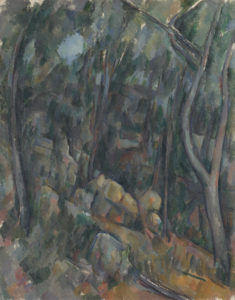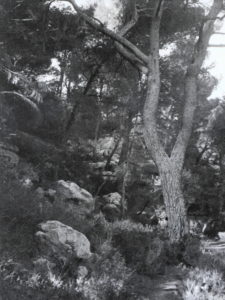R880 – Sous-bois devant les grottes au-dessus du Château Noir, 1900-1904 (FWN335)
Pavel Machotka
(Cliquer sur les images pour les agrandir)
So candid a use of the technique of Dans le parc du Château Noir is, however, rare. In the following landscape, Sous-bois devant les grottes au-dessus de Château Noir, from the Château Noir property like the Dans le parc du Château Noir and La Meule et citerne en sous-bois pictures, the painter had to resolve a more typically untidy composition and faced a more complex and subtle range of colors. The canopy of trees was denser than in the other two Château Noir pictures and the tonality of the landscape darker: nearly all was in shadow, inviting the use of grey-violet tints close to the greyish greens and blues, but one rock was in the sun, offering a focus for the composition. With an orange tint added to its natural creamy color, the rock gave the painting a perfect color balance. The Rewald photograph came as close as it could to finding similar patches of light, but a few burst upon the trunk of the extraordinary tree, and I have taken the liberty of darkening them.
The painting is as understated as Rochers à Fontainebleau — for the same reason — and once again masterly. Yet its complexity demanded even more care in its execution. For example, the background canopy of leaves, moving in every direction, needed to be rendered by patches that parallel the slightly inclined tree trunks; and the nearest rock needed to be reduced in size to let the one behind it be seen clearly (and take its place in the same plane as the twisted tree). In all other respects, the site is a happy discovery: the sharp, diagonal branch at the top parallels the slope exactly, and the bulging trunk pushes to the left, against all that is sliding downhill, before it returns back to the right. The resonances are already present; the canvas’s rhythm, provided by the painter, follows their compelling note.
Source: Machotka, Cézanne: Landscape into Art.



